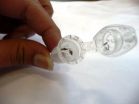(Press-News.org) GREENBELT, Md. -- New supercomputer simulations tracking the interactions of thousands of dust grains show what the solar system might look like to alien astronomers searching for planets. The models also provide a glimpse of how this view might have changed as our planetary system matured.
"The planets may be too dim to detect directly, but aliens studying the solar system could easily determine the presence of Neptune -- its gravity carves a little gap in the dust," said Marc Kuchner, an astrophysicist at NASA's Goddard Space Flight Center in Greenbelt, Md. who led the study. "We're hoping our models will help us spot Neptune-sized worlds around other stars."
The dust originates in the Kuiper Belt, a cold-storage zone beyond Neptune where millions of icy bodies -- including Pluto -- orbit the sun. Scientists believe the region is an older, leaner version of the debris disks they've seen around stars like Vega and Fomalhaut.
"Our new simulations also allow us to see how dust from the Kuiper Belt might have looked when the solar system was much younger," said Christopher Stark, who worked with Kuchner at NASA Goddard and is now at the Carnegie Institution for Science in Washington, D.C. "In effect, we can go back in time and see how the distant view of the solar system may have changed."
Kuiper Belt objects occasionally crash into each other, and this relentless bump-and-grind produces a flurry of icy grains. But tracking how this dust travels through the solar system isn't easy because small particles are subject to a variety of forces in addition to the gravitational pull of the sun and planets.
The grains are affected by the solar wind, which works to bring dust closer to the sun, and sunlight, which can either pull dust inward or push it outward. Exactly what happens depends on the size of the grain.
The particles also run into each other, and these collisions can destroy the fragile grains. A paper on the new models, which are the first to include collisions among grains, appeared in the Sept. 7 edition of the Astronomical Journal.
"People felt that the collision calculation couldn't be done because there are just too many of these tiny grains too keep track of," Kuchner said. "We found a way to do it, and that has opened up a whole new landscape."
With the help of NASA's Discover supercomputer, the researchers kept tabs on 75,000 dust particles as they interacted with the outer planets, sunlight, the solar wind -- and each other.
The size of the model dust ranged from about the width of a needle's eye (0.05 inch or 1.2 millimeters) to more than a thousand times smaller, similar in size to the particles in smoke. During the simulation, the grains were placed into one of three types of orbits found in today's Kuiper Belt at a rate based on current ideas of how quickly dust is produced.
From the resulting data, the researchers created synthetic images representing infrared views of the solar system seen from afar.
Through gravitational effects called resonances, Neptune wrangles nearby particles into preferred orbits. This is what creates the clear zone near the planet as well as dust enhancements that precede and follow it around the sun.
"One thing we've learned is that, even in the present-day solar system, collisions play an important role in the Kuiper Belt's structure," Stark explained. That's because collisions tend to destroy large particles before they can drift too far from where they're made. This results in a relatively dense dust ring that straddles Neptune's orbit.
To get a sense of what younger, heftier versions of the Kuiper Belt might have looked like, the team sped up the dust production rate. In the past, the Kuiper Belt contained many more objects that crashed together more frequently, generating dust at a faster pace. With more dust particles came more frequent grain collisions.
Using separate models that employed progressively higher collision rates, the team produced images roughly corresponding to dust generation that was 10, 100 and 1,000 times more intense than in the original model. The scientists estimate the increased dust reflects conditions when the Kuiper Belt was, respectively, 700 million, 100 million and 15 million years old.
"We were just astounded by what we saw," Kuchner said.
As collisions become increasingly important, the likelihood that large dust grains will survive to drift out of the Kuiper Belt drops sharply. Stepping back through time, today's broad dusty disk collapses into a dense, bright ring that bears more than a passing resemblance to rings seen around other stars, especially Fomalhaut.
"The amazing thing is that we've already seen these narrow rings around other stars," Stark said. "One of our next steps will be to simulate the debris disks around Fomalhaut and other stars to see what the dust distribution tells us about the presence of planets."
The researchers also plan to develop a more complete picture of the solar system's dusty disk by modeling additional sources closer to the sun, including the main asteroid belt and the thousands of so-called Trojan asteroids corralled by Jupiter's gravity.
INFORMATION:
For more information, images and animations on the Web, visit:
http://www.nasa.gov/topics/solarsystem/features/dust-model.html
Dust models paint alien's view of the solar system
2010-09-24
ELSE PRESS RELEASES FROM THIS DATE:
New species of multi-horned dinosaurs unearthed in Utah
2010-09-24
"A giant rhino with a ridiculously supersized head."
"Fifteen long, pointed sideways oriented eye horns: one over the nose, one atop each eye, one at the tip of each cheek bone, and ten across the rear margin of the bony frill."
"A horned face: large horn over the nose and short, blunt eye horns that project strongly to the side."
Such phrases have been used to describe two newly discovered species of dinosaurs with looks only a mother could love. Still, they are drawing the attention and inspiring the imagination of scientists and lay people alike.
Announced today ...
More predators doesn't equal more danger for urban bird nest
2010-09-24
COLUMBUS, Ohio – While birds living in urban areas face more predators than do those in rural areas, that doesn't mean urban birds face more danger from nest robbers.
A six-year study conducted in 19 central Ohio forests from 2004 to 2009 found that, as expected, rural areas that had higher numbers of nest predators such as raccoons, domestic cats, and crows, also showed lower rates of nest survival.
But there was no relation between the number of predators and nest survival in more urbanized areas.
Researchers believe that's because nest predators in urban areas ...
Increased attention to women's health research has yielded gains on some important conditions, but progress lags on others
2010-09-24
WASHINGTON -- A concerted effort to boost research on women's health over the last two decades has lessened the burden of disease and reduced deaths among women due to cardiovascular disease, breast cancer, and cervical cancer, says a new report from the Institute of Medicine. The effort has yielded less but still significant progress in reducing the effects of depression, HIV/AIDS, and osteoporosis on women, added the committee that wrote the report.
However, several health issues important to women have seen little progress, including unintended pregnancy, autoimmune ...
Everglades restoration program making tangible progress after 10 years; challenges ahead to meet both water quality and quantity goals
2010-09-24
WASHINGTON -- A decade-long, multibillion dollar effort to restore the Florida Everglades has made tangible albeit slow progress, but additional projects need completion before substantial benefits are seen, says a new congressionally mandated report from the National Research Council. Challenges in achieving targets for both water quality and water flow have become more apparent, requiring further scientific analysis to determine the repercussions of trading off one for the other. Although important scientific advances have been made, continued decline of some aspects ...
Vitamin C rapidly improves emotional state of acutely hospitalized patients, say LDI researchers
2010-09-24
Treatment with vitamin C rapidly improves the emotional state of acutely hospitalized patients, according to a study carried out by researchers at Montreal's Jewish General Hospital (JGH) and the affiliated Lady Davis Institute for Medical Research (LDI).
In a double-blind clinical trial, patients admitted to the JGH were randomly assigned to receive either vitamin C or vitamin D supplements for seven to ten days. Patients administered vitamin C had a rapid and statistically and clinically significant improvement in mood state, but no significant change in mood occurred ...
Scientists recreate extreme conditions deep in Earth's interior
2010-09-24
New Haven, Conn.—Scientists have wondered for some time why certain seismic waves travel more quickly through the core-mantle boundary, a thin layer of the Earth's interior that lies between about 1675 and 1800 miles below the surface. Now a new study by Yale University and the University of California, Berkeley sheds light on the mystery by showing how this region behaves under the extreme conditions found so deep in the Earth. The findings, which appear in the Sept. 24 issue of the journal Science, have important implications for understanding how the Earth's internal ...
Current decisions shape your future preferences
2010-09-24
Psychologists have known for a long time that after you make a choice, you adjust your opinion to think better of the thing you chose. Now a new study has found that this is true even if you don't know the options that you're choosing between.
People change their minds about a choice after they make it. If you ask someone how he feels about Athens and Paris, he might rate them the same. But after you make him choose one as a vacation destination, he'll rate that city higher. This is thought to be a way to reduce the psychological tension that is created by rejecting ...
Arctic soil study turns up surprising results
2010-09-24
Across the globe, the diversity of plant and animal species generally increases from the North and South Poles towards the Equator but surprisingly that rule isn't true for soil bacteria, according to a new study by Queen's University biology professor Paul Grogan.
"It appears that the rules determining the patterns for plant and animal diversity are different than the rules for bacteria," says Professor Grogan.
The finding is important because one of the goals in ecology is to explain patterns in the distribution of species and understand the biological and environmental ...
New technique uncovers hidden insecticide resistance
2010-09-24
A new technique pioneered at Liverpool School of Tropical Medicine (LSTM) is improving the detection and monitoring of insecticide resistance in field populations of an important malaria-carrying mosquito.
Researchers at LSTM, led by Dr Charles Wondji have developed a new technique which encourages the female Anopheles funestus mosquitoes to lay eggs which are then reared into adult mosquitoes to provide sufficient numbers to determine levels of insecticide resistance and to characterise the underlying mechanisms.
Explaining the significance, John Morgan, who designed ...
Patients with cancer who stop hospice care boost health-care costs
2010-09-24
Researchers at Mount Sinai School of Medicine have found that the costs of care for patients with cancer who disenrolled from hospice were nearly five times higher than for patients who remained with hospice. Patients who disenroll from hospice are far more likely to use emergency department care and be hospitalized. The results are published in the October 1 issue of the Journal of Clinical Oncology.
Led by Melissa D.A. Carlson, PhD, Assistant Professor of Geriatrics and Palliative Medicine, and Elizabeth H. Bradley, PhD, Professor of Public Health at Yale University, ...


